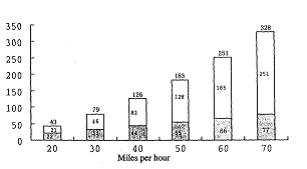题目内容
Detectives often look for footprints when they try to solve crimes. Scientists use footprints, too—dinosaur footprints when they try to figure out how dinosaurs lived and moved.
Dinosaurs died out about 65 million years ago. Today scientists work to solve the mysteries of these ancient animals.
Footprints, or tracks(脚印), are an important way to learn about dinosaurs. Christian Meyer of the Natural History Museum in Basel, Switzerland, calls dinosaur tracks “the closest thing to a movie” of dinosaurs.
“They tell us something about the size of the animal, the way they were walking…they tell us something about their speed,” Meyer said.
Tracks also show that dinosaurs sometimes traveled in groups. Traveling in groups probably helped dinosaurs protect themselves from enemies. Plus, some meat-eating dinosaurs may have hunted in groups, much like wolves do today. Bein g in a group could help dinosaurs work together to kill large animals.
g in a group could help dinosaurs work together to kill large animals.
Dinosaur footprints can be as small as a few inches across, but they can also be as big as a few feet across. Dinosaur footprints have been found throughout the world at ove r 1,500 sites, including a T. Rex footprint in New Mexico. “Trackways” are groups of footprints.
r 1,500 sites, including a T. Rex footprint in New Mexico. “Trackways” are groups of footprints.
And scientists aren’t the only ones finding dinosaur tracks—kids can, too! Eleven-year-old Mark Turner and nine-year-old Daniel Helm discovered dinosaur tracks in British Columbia, anada. Soon scientists began studying the tracks.
Scientists and other people interested in studying dinosaurs are working to save the trackways from activities like construction and mining.
小题1:The passage mainly tells us that_______.
A. there were really dinosaurs on the earth millions of years ago
B. dinosaurs were the most frightening animals in the past
C. dinosaur footprints are important in learning about dinosaurs
C. why dinosaurs died out millions of years ago
小题2:By studying footprints scientists can know the following EXCEPT _______.
小题3: By working in groups, some meat-eating dinosaurs_______.
小题4: From the last paragraph we can infer that some human activities like mining_______.
Dinosaurs died out about 65 million years ago. Today scientists work to solve the mysteries of these ancient animals.
Footprints, or tracks(脚印), are an important way to learn about dinosaurs. Christian Meyer of the Natural History Museum in Basel, Switzerland, calls dinosaur tracks “the closest thing to a movie” of dinosaurs.
“They tell us something about the size of the animal, the way they were walking…they tell us something about their speed,” Meyer said.
Tracks also show that dinosaurs sometimes traveled in groups. Traveling in groups probably helped dinosaurs protect themselves from enemies. Plus, some meat-eating dinosaurs may have hunted in groups, much like wolves do today. Bein
 g in a group could help dinosaurs work together to kill large animals.
g in a group could help dinosaurs work together to kill large animals.Dinosaur footprints can be as small as a few inches across, but they can also be as big as a few feet across. Dinosaur footprints have been found throughout the world at ove
 r 1,500 sites, including a T. Rex footprint in New Mexico. “Trackways” are groups of footprints.
r 1,500 sites, including a T. Rex footprint in New Mexico. “Trackways” are groups of footprints.And scientists aren’t the only ones finding dinosaur tracks—kids can, too! Eleven-year-old Mark Turner and nine-year-old Daniel Helm discovered dinosaur tracks in British Columbia, anada. Soon scientists began studying the tracks.
Scientists and other people interested in studying dinosaurs are working to save the trackways from activities like construction and mining.
小题1:The passage mainly tells us that_______.
A. there were really dinosaurs on the earth millions of years ago
B. dinosaurs were the most frightening animals in the past
C. dinosaur footprints are important in learning about dinosaurs
C. why dinosaurs died out millions of years ago
小题2:By studying footprints scientists can know the following EXCEPT _______.
| A.how big the dinosaur was | B.what color the dinosaur was |
| C.how fast the dinosaur could run | D.how the dinosaur walked |
| A.made the hunting of large animals easily |
| B.could travel a long way without being lost |
| C.could protect themselves from being hunted by wolves |
| D.could get to a place faster |
| A.are helpful to the study of dinosaurs |
| B.can help scientists solve many mysteries |
| C.can lead to the discovery of the footprints |
| D.can destroy the footprints of the dinosaur |
小题1:C 小题1: B小题1:A小题1:D
略

练习册系列答案
 阅读快车系列答案
阅读快车系列答案
相关题目
 out of the center to work, and back to the center in the evenings. The inner zone will be cleaner and better to live in and there will be more space for industry on the outside.
out of the center to work, and back to the center in the evenings. The inner zone will be cleaner and better to live in and there will be more space for industry on the outside. edge is guiding their development,” vanMarle said.
edge is guiding their development,” vanMarle said. rs
rs